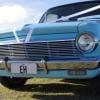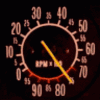hi building pretty tuff 202 my engine man wants to knife edge the crank any benefit.. worth the money or not??

knife edge crank 202
#1

Posted 26 June 2015 - 03:53 PM
#2

Posted 26 June 2015 - 04:19 PM
for got to say dont no price yet ![]()
#3
 _Agent 34_
_Agent 34_
Posted 26 June 2015 - 06:33 PM
i'm going to have a go at this;
and say this slowly to yourself,
" am I going to running this car in a race environment where by i need to gain a benefit from lightening the crank or trying to crack the 12sec 1/4 , I would be better off spending my money on a very well ported head which is where all the power is in a holden 6"
If the answer is no to the above then stay with a full weight.
It really depends on the frequency on " how many times you will go up and down the entire rev range" if it's once in a blue moon then no, if its every time you drive it on the track then maybe.
1 and a half cents - pretty cheap to lighten a crank these days - getting if right is the expensive part.
go with someone who knows what they are doing is my other 1 and a half cents.
There are plenty of quick 6 cars around with a full crank - focus on " the head " and put your money there.
there are some talented people on this forum who can give a lot more advice than what i am giving you.
he may be at the pie shop getting an apple turnover. or racing his FJ ute in a straight line
G
Edited by Agent 34, 26 June 2015 - 06:35 PM.
#4
 _Bomber Watson_
_Bomber Watson_
Posted 26 June 2015 - 06:45 PM
Certainly wouldnt say im qualified to answer this either but for the average 280-300hp engine its not something I would have on the top of my list, my new engine will have a full weight crank, and im certainly chasing as close to 300 as i can get out of it.
Reason being, Even the blue motor crank is really a bit on the light side form what i've gathered, particularly when you compare it to a RB/JZ/XR6 etc engine, so im far more concerned with getting weight out of the slugs and rods.
As above, carbs head exhaust make power. Cam should be chosen to work best with those three, bottom end just needs to stay in one piece long enough to be usefull.
Cheers.
#5
 _reefhog_
_reefhog_
Posted 26 June 2015 - 06:54 PM
#6
 _Agent 34_
_Agent 34_
Posted 26 June 2015 - 07:08 PM
Bomber - be interesting to see if knife edging the crank affected the torque curve on a motor in identical runs - pre knife edging and post with same set up. post
torque is the factor of moving one weight against another.
engine hp vs car weight vs road traction
there is a few variables there !
#7
 _Bomber Watson_
_Bomber Watson_
Posted 26 June 2015 - 07:15 PM
I highly doubt you would notice it much, after all with a manual transmissioned car once the clutch is disengaged you are spinning not only the crank, flywheel and clutch, but also the mainshaft, layshaft, tailshaft, diff center, axles, wheels and tyres.....Just counting the big items.
I know a lot of people flog on about the huge improvement 1kg less flywheel weight made over the performance of there car but in a pure acceleration run I highly doubt you would notice it....After all were not talking F1 here.
Cheers.
#8
 _STRAIGHTLINEMICK_
_STRAIGHTLINEMICK_
Posted 26 June 2015 - 07:48 PM
i'm going to have a go at this;
and say this slowly to yourself,
" am I going to running this car in a race environment where by i need to gain a benefit from lightening the crank or trying to crack the 12sec 1/4 , I would be better off spending my money on a very well ported head which is where all the power is in a holden 6"
If the answer is no to the above then stay with a full weight.
It really depends on the frequency on " how many times you will go up and down the entire rev range" if it's once in a blue moon then no, if its every time you drive it on the track then maybe.
1 and a half cents - pretty cheap to lighten a crank these days - getting if right is the expensive part.
go with someone who knows what they are doing is my other 1 and a half cents.
There are plenty of quick 6 cars around with a full crank - focus on " the head " and put your money there.
there are some talented people on this forum who can give a lot more advice than what i am giving you.
he may be at the pie shop getting an apple turnover. or racing his FJ ute in a straight line
,
The benefit from the lightened crank is quicker acceleration from about 3-5 kg less weight and less windage . Its increased power and acceleration for no loss in drivability.
In some applications such as a manual trans drag engine without much low end torque it may benefit to leave the weight there and the increased inertia will make up for less torque to help 60ft times but the heavy weight will not help when you are trying to accelerate thru gears . It is a balancing act for this type of engine .
But for a street/strip or circuit car the light weight is a win win situation,think about it blokes and weigh it up for yourself , its horses for courses .
If you have a different opinion that comes from your own experience then id like to hear it .
Edited by STRAIGHTLINEMICK, 26 June 2015 - 07:50 PM.
#9

Posted 27 June 2015 - 12:17 AM
#10

Posted 27 June 2015 - 12:32 AM
Mick does exchange Crank knife machining Jonesy.
Blue would be the go. ![]()
If Black is better, I need to know. ![]()
#11

Posted 27 June 2015 - 12:54 AM
Unless they used space age carbonic laced titanium/iron mix in the black cranks?!
And if I ever need a knife edged crank/rod combo, Mick will be the man.
#12

Posted 27 June 2015 - 06:12 AM
Like Bomber mentioned earlier, I personally think they need to be heavier, not lighter, I'm not knocking what Mick does, but I've run my std blue crank in the LJ to 12.16@109 mph with a 23lb(10.4kg)flywheel & a 4kg balancer. Spend the money on the head, like Agent 34 said, thta's the handbrake with the Holden six.
#13
 _oldjohnno_
_oldjohnno_
Posted 27 June 2015 - 09:29 AM
Personally I wouldn't even consider it.
#14
 _STRAIGHTLINEMICK_
_STRAIGHTLINEMICK_
Posted 27 June 2015 - 10:16 AM
Like Bomber mentioned earlier, I personally think they need to be heavier, not lighter, I'm not knocking what Mick does, but I've run my std blue crank in the LJ to 12.16@109 mph with a 23lb(10.4kg)flywheel & a 4kg balancer. Spend the money on the head, like Agent 34 said, thta's the handbrake with the Holden six.
I agree with warren in spending your money on the head ,induction and exhaust first if your budget is limited because most of your improvement will be found there .
#15
 _Bomber Watson_
_Bomber Watson_
Posted 27 June 2015 - 11:03 AM
Or did you go back to a full weight crank with the new engine?
#16

Posted 27 June 2015 - 11:54 AM
thank guys (its a blue crank) i think if he wants to do it and with in the budget i will but if it comes out of my pocket then i will say no thanks.. the head has had a lot done to it all ready (flowed 300 hp) so dont need to do any more there for what the build is.
thanks for the input
#17

Posted 27 June 2015 - 05:57 PM
#18

Posted 27 June 2015 - 06:00 PM
#19
 _Bomber Watson_
_Bomber Watson_
Posted 27 June 2015 - 08:01 PM
Yep righto, so airplane winged as opposed to knife edged, gotcha now.
Been a while since i've seen the picks, and thought you might have scrapped the idea for some reason.
Cheers.
#20

Posted 27 June 2015 - 09:12 PM
I'm no expert on knife edging cranks however I read an article some time ago and the latest train of thought is the drag created by the trailing edge of the counterweight is more of an issue than the leading edge punching through the oil laden air. Put simply, think about the shape of a ships hull and how it glides through the water.
#21
 _oldjohnno_
_oldjohnno_
Posted 27 June 2015 - 10:19 PM
Think about this: at 7000rpms the circumference of a 6" diameter crankshaft will be travelling at around 120mph.
We all know that an object with tapered leading and trailing edges - like a wing or a ships hull - travelling at that speed will have less drag than a blunt, block shaped object. It makes sense; a smooth tapered shape will disrupt the surrounding fluid much less and cause much less turbulence and therefore create much less drag.
But we also know that the above applies only if the surrounding fluid is fairly calm and the relative flow past the object is largely laminar. If the flow is already turbulent then pretty much all the advantages of an aerodynamic shape go out the window.
How would you describe the air that immediately surrounds a crank and rods thrashing at 7000rpm, with pistons pumping the crankcase air at the same rate? A picture of tranquillity?
Now, I'm well aware that there are good gains to be had from keeping the oil away from the crank. I just can't see slicking up the crank cheeks achieving much. I think you'd gain much more with crankcase vacuum - not only would you manage the oil wrap problem but you'd also reduce the air drag. And without all the filthy work involved in shaping a cast iron crankshaft.
#22

Posted 27 June 2015 - 10:29 PM
Oldjohnno put us in the crankcase front seat.
Like Button for You. ![]()
![]()
possibly why they have dry sumps.
#23
 _Bomber Watson_
_Bomber Watson_
Posted 27 June 2015 - 10:38 PM
OJ, whats your thoughts on just running a sander over the counterweights to take the casting dags and general roughness off, whilst leaving the shape as is? waste of half an hour?
Cheers.
#24
 _oldjohnno_
_oldjohnno_
Posted 27 June 2015 - 11:44 PM
OJ, whats your thoughts on just running a sander over the counterweights to take the casting dags and general roughness off, whilst leaving the shape as is? waste of half an hour?
Cheers.
There may be some small advantage, I don't really know. I wouldn't bother with it myself though, I think I could spend the time more productively.
#25
 _duggan208_
_duggan208_
Posted 27 June 2015 - 11:47 PM
Well all I'm doing is getting rid of all the stress risers, casting dags etc, bull nosing the leading edge of the counterweight. I've decided to leave the trailing edge because at goodness knows how many times a second the counterweight spins, the leading edge is following the trailing edge's wake. Its a bastard of a dirty job, takes up heaps of hours, but may as well just do it, similar to a Scat crank.
I like the vacuum pump idea. expensive dam things. i tried a Jap smog pump but bloody useless. would love to try a proper Moroso pump. V8 super car use them.
regards
1 user(s) are reading this topic
0 members, 1 guests, 0 anonymous users






 View Garage
View Garage









